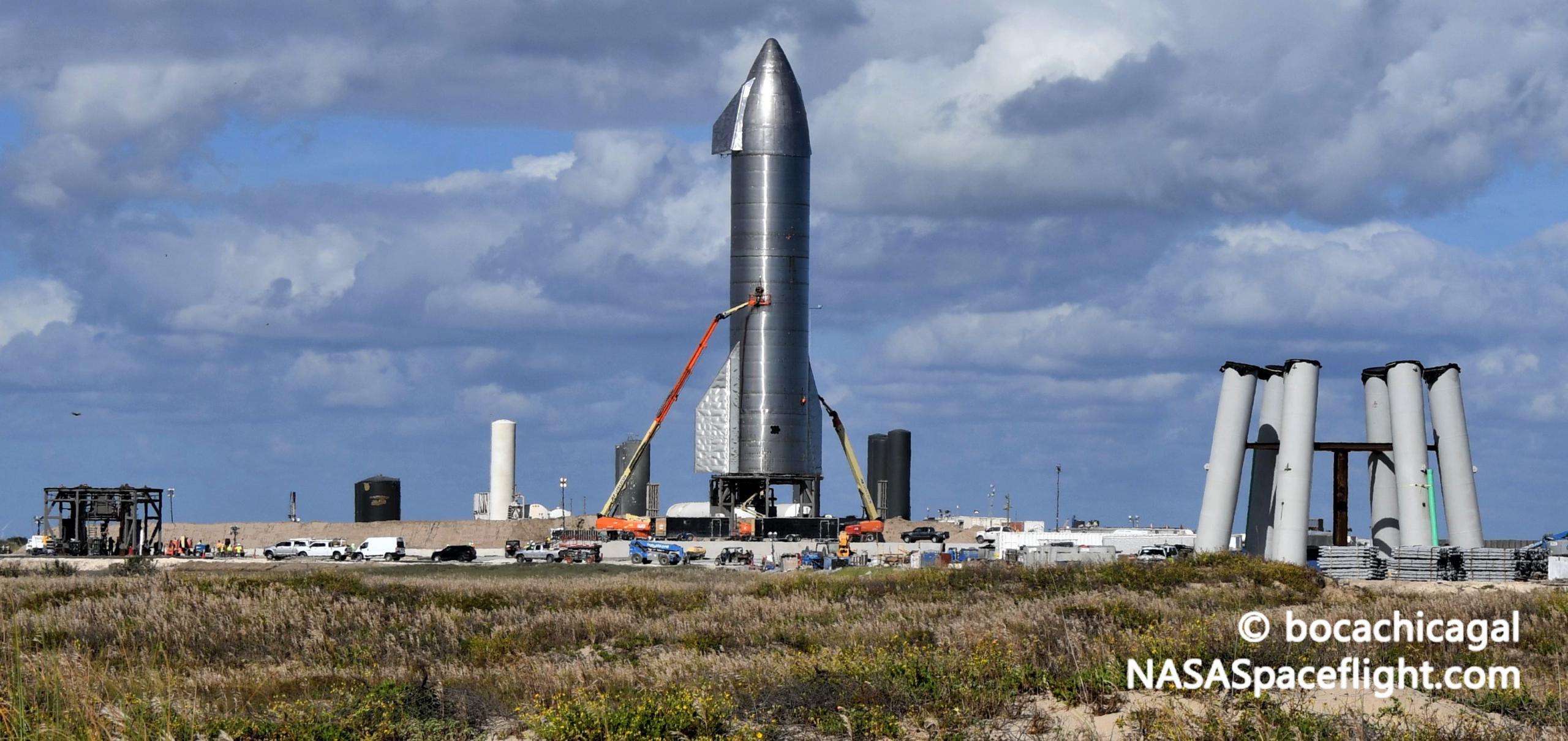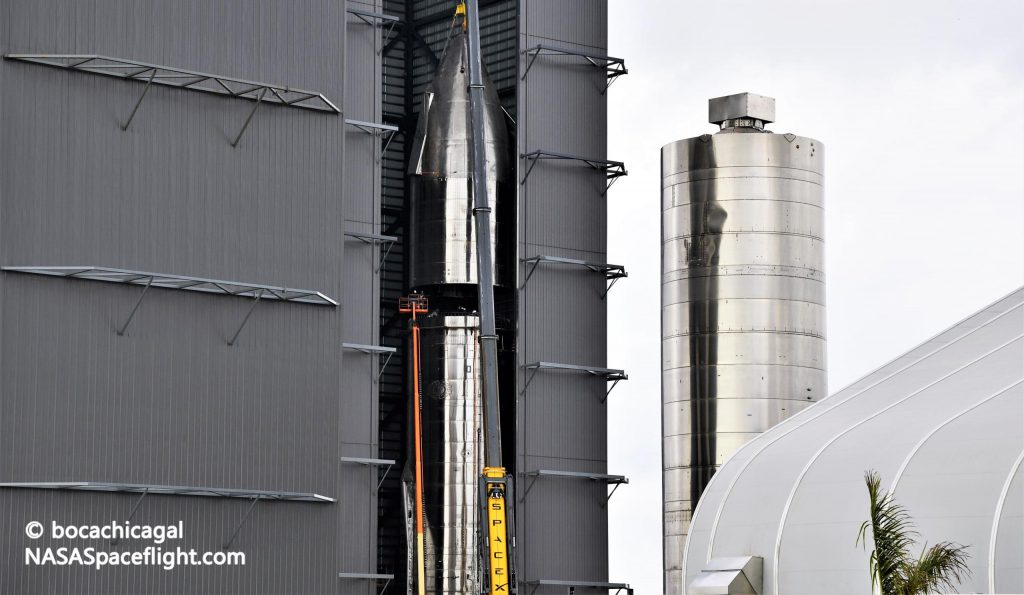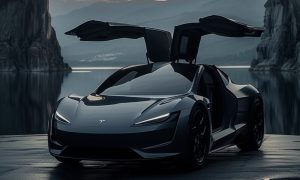

News
SpaceX sets dates for Starship static fire, high-altitude launch debut
CEO Elon Musk says that SpaceX is set to attempt one final Raptor engine static fire test before putting Starship through its high-altitude launch debut later this week.
Liable to begin as soon as November 30th per public road closure notices, Musk says that Starship serial number 8’s (SN8) launch debut – both Starship’s first fully-assembled flight test and first high-altitude launch attempt – is now scheduled no earlier than (NET) 8 am to 5 pm CST (UTC-6) on Wednesday, December 2nd.
November 30th will instead host what is believed to be a unique kind of static fire test for Starship SN8, hopefully proving that the rocket has a decent shot at surviving its risky launch debut.
As previously discussed on Teslarati, SpaceX’s Starship development strategy means that SN8’s survival is far less important than it may seem.
“On November 25th, Starship SN9 (featuring “small improvements”) was stacked to its full 50-meter (~165 ft) height. If SN8 is destroyed during testing, SN9 will likely be ready to roll to the launch site almost as soon as the dust settles.
Meanwhile, Starship SN10 is likely just 7-10 days away from a similar nosecone stacking milestone, and Starship SN11’s tank section is just one stack away from completion, likely putting it less than two weeks behind SN10. In other words, insofar as speed is a priority and each prototype is anywhere close to as cheap as Starship’s majority-steel bill of materials might suggest, SpaceX is building Starships so quickly that it almost doesn’t make sense to spend more than a few weeks working through bugs on any single suborbital ship.”
Teslarati.com — November 25th, 2020
In fact, delaying SN8’s launch to try to refine the rocket in situ and better ensure success could actually be to the detriment of successive prototypes and the Starship program in general. If, for example, a fundamental design flaw is revealed in Starship SN8 only after the prototype’s first test flight, SpaceX could be forced to scrap a huge amount of work done on as many as six, seven, eight, or even more subsequent prototypes. In that since, while it may seem like caution maximizes the value any single Starship prototype can provide SpaceX, that’s only true as long as the Starship design is mature enough that new fundamental flaws are unlikely to arise.
Given how young SpaceX’s agile Starship development program is, it would make very little sense to hinge months of work and more than half a dozen rocket prototypes on the quality and success of a less mature prototype unless all the vehicles in question are more or less identical final products. SN8 through SN15+ are certainly not final products in the sense that Starship is meant to be the largest reusable orbital spacecraft ever built.
As such, the Starship program is probably better off if SpaceX pushes vehicles to failure as quickly as reasonably possible. Having now spent more than two months at the launch pad while no less than three full-scale prototypes rapidly approach a similar level of completion, Starship SN8’s test flow is likely an overcorrection from a haphazardly rushed schedule to extreme caution.
Along those lines, SpaceX is now hopefully set on launching Starship SN8 within the near future. First, though, the company apparently plans to attempt another Raptor engine static fire test on Monday, November 30th. Scheduled between 7 am and 9 pm CST, the test has been described as a “handoff” static fire, referring to the process of switching each Raptor engine’s propellant feed from Starship’s main tank to much smaller ‘header’ tanks reserved for landings.


What exactly that handoff refers to is unclear. It could mean that SN8 will switch from main tanks to header tanks during a Raptor static fire test, though it’s unclear why that capability would be necessary unless Starship’s current header tank design is too small. “Handoff” could also refer to the process of switching between main and header tanks between Raptor operations – far more likely. In other words, Starship SN8’s Monday testing might involve two back-to-back static fires, performed with no human intervention. If successful, such a handoff static fire would simultaneously test Starship’s ability switch propellant sources and perform multiple Raptor engine ignitions – both necessary for a launch and landing.

Musk himself believes that Starship SN8 has a ~33% chance of successfully launching, reaching apogee, stably ‘skydiving’ ~14 km (~9 mi) back to Earth, reigniting Raptor engines, and landing in one piece. It’s unclear what will happen in the seemingly unlikely event that SN8 survives, but Starship SN9 is practically nipping at the relatively ancient prototype’s heels.
News
Tesla Robotaxi has already surpassed Waymo in this key metric
Tesla Robotaxi has already overtaken Waymo in Austin in one key metric, but there’s still more work to do.

Tesla Robotaxi has already surpassed Waymo in one extremely important key metric: size of service area.
Tesla just expanded its service area in Austin on Monday morning, pushing the boundaries of its Robotaxi fleet in an interesting fashion with new capabilities to the north. Yes, we know what it looks like:
🚨 Tesla’s new Robotaxi geofence is…
Finish the sentence 🥸 pic.twitter.com/3bjhMqsRm5
— TESLARATI (@Teslarati) July 14, 2025
The expansion doubled Tesla Robotaxi’s potential travel locations, which now include the University of Texas at Austin, a school with over 53,000 students.
The doubling of the service area by Tesla has already made its travel area larger than Waymo’s, which launched driverless rides in October 2024. It became available to the public in March 2025.
According to Grok, the AI agent on X, Tesla Robotaxi’s current service area spans 42 square miles, which is five square miles larger than Waymo’s service area of 37 square miles.
Tesla Robotaxi (red) vs. Waymo geofence in Austin.
Much can be said about the shape… but the Robotaxi area is now ~3.9 mi² (10 km²) larger than Waymo’s!! pic.twitter.com/dVfh2ODxJC
— Robin (@xdNiBoR) July 14, 2025
The service area is one of the most important metrics in determining how much progress a self-driving ride-hailing service is making. Safety is the priority of any company operating a ride-hailing network, especially ones that are making it a point to use autonomy to deploy it.
However, these companies are essentially racing for a larger piece of the city or cities they are in. Waymo has expanded to several different regions around the United States, including Arizona and Los Angeles.
Tesla is attempting to do the same in the coming months as it has already filed paperwork in both California and Arizona to deploy its Robotaxi fleet in states across the U.S.
As the platform continues to show more prowess and accuracy in its operation, Tesla will begin to expand to new areas, eventually aiming for a global rollout of its self-driving service.
News
Tesla Megapacks arrive for massive battery replacing coal plant
Tesla Megapacks have started arriving on-site to the Stanwell Battery Project, just as Queensland prepares to wind down the Stanwell coal plant.

The first of over 300 Tesla Megapacks have arrived to the site of a massive battery energy storage system (BESS) being built in Australia, dubbed the Stanwell Battery Project after a coal plant it’s set to replace.
In a press release last week, the Stanwell Battery Project announced that the first Tesla Megapack 2XL units had arrived to the site, which is located outside of Rockhampton in Queensland, Australia. The project will eventually feature 324 Megapack units, set to arrive in the coming months, in order to support the 300MW/1,200MWh battery project.
“The Stanwell Battery is part of the diversification of our portfolio, to include cleaner and more flexible energy solutions,” said Angie Zahra, Stanwell Central Generation General Manager. “It is just one part of the 800 MW of battery energy storage capacity we have in our pipeline.
“Capable of discharging 300 MW of energy for up to four hours (1,200 MWh), our mega battery will be one of the largest in Queensland.”

Credit: Stanwell
Did you know Tesla’s Lathrop facility churns out a Megapack every 68 minutes? That’s enough energy to power 3,600 homes for an hour per unit! ⚡️ pic.twitter.com/bG6fpHkB9O
— TESLARATI (@Teslarati) June 11, 2025
READ MORE ON TESLA MEGAPACKS: Tesla Lathrop Megafactory celebrates massive Megapack battery milestone
The state is working with government-owned company Yurika to facilitate construction, and the process is expected to create roughly 80 jobs. The project is expected to come fully online in May 2027, with initial commissioning of the Megapacks aiming for November 2025.
The Stanwell Battery is set to replace the nearby Stanwell coal generation plant, which the government is planning to wind down starting in 2026 as part of efforts to reach an 80 percent renewable energy generation ratio by 2035. Meanwhile, the government is also set to begin winding down the Tarong and Callide coal plants, while several other Megapack projects are being built or coming online. o ya
Tesla currently has two Megapack production facilities, located in Lathrop, California, in the U.S. and another that came online earlier this year in Shanghai, China. The Shanghai Megafactory shipped its first units to Australia in March, while both factories are expected to be capable of producing 10,000 Megapack units per year upon reaching volume production.
News
The Tesla Diner is basically finished—here’s what it looks like
The company first broke ground on the Diner, Drive-in, and Supercharger location in September 2023. Now, it has served one of its first internal customers.

Tesla has finally completed the construction of its highly anticipated Diner, Drive-in, and Supercharger in Los Angeles, and recent photos of the interior’s “retro-futuristic” style are making their way around the internet.
X user Brad Goldberg shared photos from the Tesla Diner site last Tuesday, depicting some of the Supercharger stalls, indoor and outdoor seating areas, multiple neon lights, and even an Optimus robot. Goldberg also noted that there had been a “flurry of activity on site” while he was snapping the photos last week, suggesting that the restaurant location could be getting close to opening.
The Tesla Diner also served one of its first internal customers in the past few days, as Elon Musk posted on X on early Monday morning that he had just finished up eating a meal at the site:
I just had dinner at the retro-futuristic Tesla diner and Supercharger.
Team did great work making it one of the coolest spots in LA!
The photos also show that the site is pretty much done, with some of them even showing vehicles charging at the charging stalls.
You can see some of the latest photos of the Tesla Diner below.

Credit: BradGoldbergMD | X

Credit: BradGoldbergMD | X

Credit: BradGoldbergMD | X

Credit: BradGoldbergMD | X

Credit: TeslaKing420 | X

Credit: TeslaKing420 | X

Credit: Brad Goldberg (via Sawyer Merritt on X)

Credit: Brad Goldberg (via Sawyer Merritt on X)

Credit: Brad Goldberg (via Sawyer Merritt on X)

Credit: Brad Goldberg (via Sawyer Merritt on X)

Credit: Brad Goldberg (via Sawyer Merritt on X)
READ MORE ON TESLA’S LA DINER: Tesla readies Drive-In Diner Supercharger for launch with app inclusion
When will the Tesla Diner open to external customers?
While it’s still not open to external customers yet, the news again suggests that the company could be close to an official opening date. Tesla first broke ground on the Diner in September 2023, after receiving a wave of building permit approvals throughout that year. Teslarati also covered much of the construction progress throughout last year, including when crews installed the first and second drive-in screens.
Located at 7001 West Santa Monica Boulevard, the idea was first discussed in 2018 by Musk and a few others on Twitter, featuring 1950s rock and roll, waiters on roller skates, and drive-in movie theater screens playing clips from some of history’s best movies. Notably, the photos of the front doors also show that the site will be open 24 hours a day, 7 days a week, whenever it does end up opening.
Tesla’s progress on Supercharger with diner, drive-in seen in aerial footage
-

 Elon Musk2 weeks ago
Elon Musk2 weeks agoTesla investors will be shocked by Jim Cramer’s latest assessment
-

 News2 days ago
News2 days agoTesla debuts hands-free Grok AI with update 2025.26: What you need to know
-

 Elon Musk4 days ago
Elon Musk4 days agoxAI launches Grok 4 with new $300/month SuperGrok Heavy subscription
-

 Elon Musk6 days ago
Elon Musk6 days agoElon Musk confirms Grok 4 launch on July 9 with livestream event
-

 News1 week ago
News1 week agoTesla Model 3 ranks as the safest new car in Europe for 2025, per Euro NCAP tests
-

 Elon Musk2 weeks ago
Elon Musk2 weeks agoxAI’s Memphis data center receives air permit despite community criticism
-

 News4 days ago
News4 days agoTesla begins Robotaxi certification push in Arizona: report
-

 Elon Musk2 weeks ago
Elon Musk2 weeks agoTesla scrambles after Musk sidekick exit, CEO takes over sales















